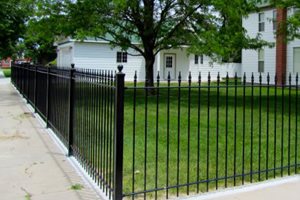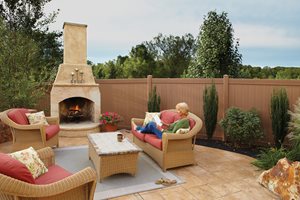In Japan, fencing with bamboo has become a fine art in traditional gardens there. In America, bamboo fencing is growing in popularity, particularly in urban and high density suburban communities. This is in part due to its natural color, texture and beauty that make it a perfect fit for Asian inspired gardens. With the new interest in green sustainable building materials, bamboo has been rediscovered for residential home improvement. Nowhere is it more useful than as both decorative screens and privacy fencing.
Swipe to view slides

This gorgeous bamboo fence demonstrates how versatile rolled bamboo stock can be when used with other materials. This is a standard timber fence composed of affordable lumber posts with top and bottom stringers. The stringers are designed with a channel to hold the limits of the rolled bamboo securely. Due to expansion and contraction of these natural materials, solid anchorage is critical to longevity. The addition of red paint, a color considered lucky in China, this blending of east and west demonstrates how well rolled bamboo lends itself to screens and solid barrier applications.
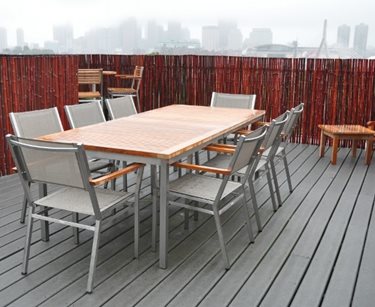
Rolled bamboo is a popular problem solver for adding privacy to otherwise open fences or railings. It's adaptability and ease of installation can totally transform the look and feel of a space for little to no cost beyond the roll stock itself. This is a fine example of how mahogany tinted bamboo fence can be used in modern landscape design or in outdoor living spaces for instant privacy or as shown here, wind protection.
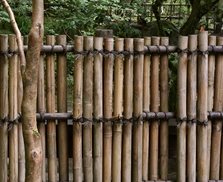
Traditional Japanese fencing is constructed from scratch using individual poles. This example shows a bamboo version of a board-on-board fence lashed together with stout cord. In many cases a wired together fence will feature the cord as a decorative element rather than structural lashing. Over time cord will deteriorate far more quickly.
Read more: Japanese Fencing
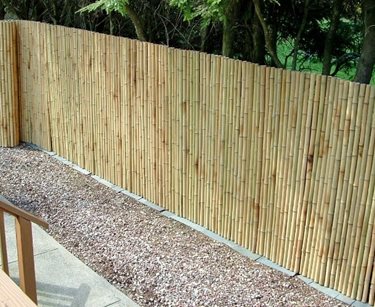
The value of rolled large cane bamboo fencing is demonstrated here as a way to disguise an unappealing chain link fence behind. The chain link, however, provides an excellent structural support for bamboo with will not allow it to sag or lean over time. This shows how well rolled bamboo solves problems in landscapes on a more practical level. However, for the Asian inspired interior or architecture, there is no better choice of fencing than bamboo.
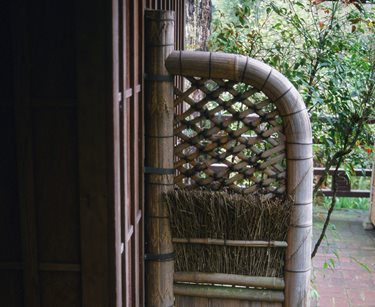
This narrow fin fence was created in the more elaborate Japanese style using a variety of different patterns and textures traditionally tied together. Such detailed work was often reserved for gates or panels in important locations in the garden. As a fin fence, bamboo panels such as this are ideal for screening off undesirable views, utilities or for added privacy. Note the integration of brush panels in this example as well as lattice and the extensive use of black cord lashing that defines this classical style.
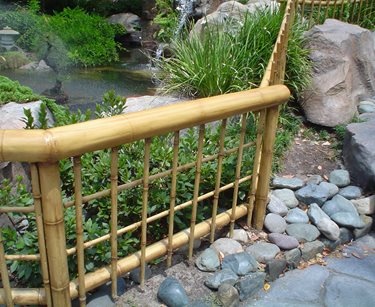
In the Asian inspired garden, low bamboo fences can define space beautifully without becoming overly oppressive. A fence such as this, using bamboo rods connected with hidden metal fasteners and wire, must be made by your contractor from scratch, which requires experience working with this unique material. To retain this blonde color and prevent moss or mildew, this fence was coated with clear acrylic sealer which helps to extend the life of the bamboo.
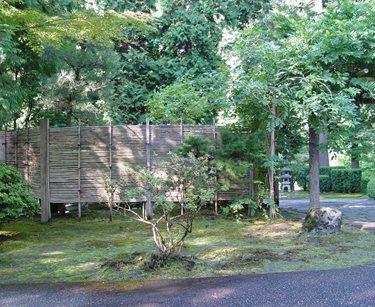
This handmade bamboo fence shows what happens to this material in the rainy Northwest. The vivid original color can, over time and under perpetually moist, shady conditions, weather to this more neutral warm gray tone. This is a simple design supported by timber 4x4s, and thinner bamboo posts in between, making a far better visual screen than a barrier fence. The horizontal alignment of the rods is unique and shows it was made by hand and does not utilize modern wire connected rolled stock.

 Backyards
Backyards
 Front Yards
Front Yards







